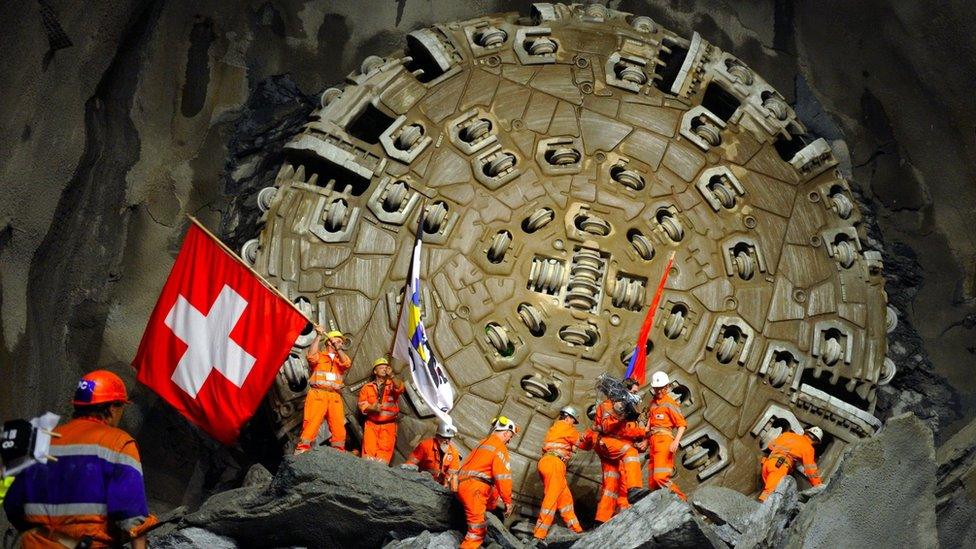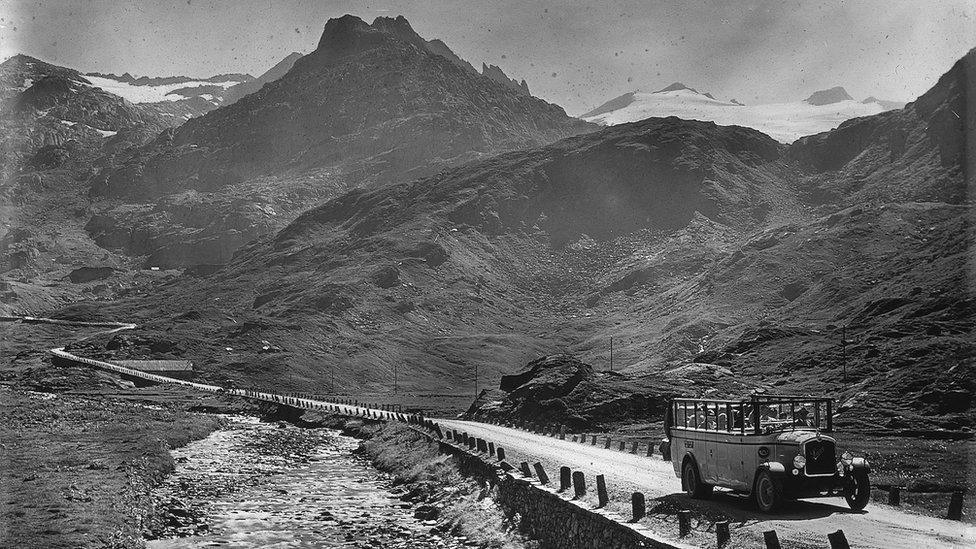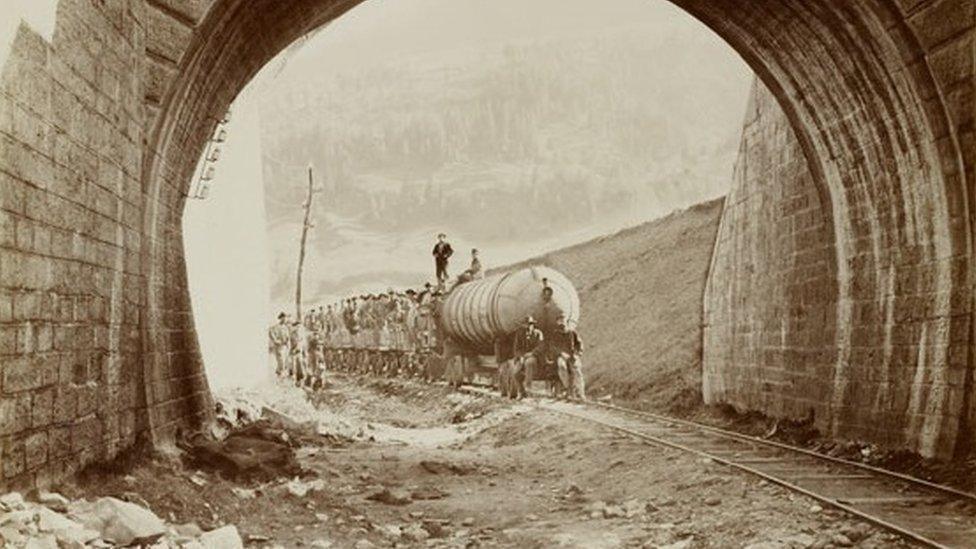Swiss Gotthard rail tunnel - an engineering triumph
- Published

A massive 10m (30-foot) boring machine was used to drill the 57.1km (35-mile) tunnel, which has taken 17 years to complete
The world's longest - and deepest - rail tunnel opens in Switzerland on Wednesday.
The Gotthard rail link has taken 20 years to build, and cost more than $12bn (£8.2bn). It will, the Swiss say, revolutionise Europe's freight transport.
The Alps are sometimes described as Europe's natural trade barriers. From Roman times, the routes across them have been mapped, and fought over.
In the Middle Ages, mule teams trekked painstakingly up the alpine passes, carrying everything from salt to wine, metal and leather goods. Accidents were common, and, in winter, the routes were closed.
So, when the first rail tunnel through the Gotthard opened in 1882 the then president of Switzerland, Simeon Bavier, could not contain his euphoria: "A triumph of art and science, a monument to work and diligence! The barrier which divided nations has fallen, the [Swiss Alps] have been breached. Countries have moved closer to each other, the world market is open!"

Today, Italian olive oil destined for the Netherlands or German cars for Greece all still have to cross the Alps. So too do many thousands of tonnes of goods from China or India: they may dock in Rotterdam, but their final destination could be Rome, Vienna or Zagreb.
The existing routes across the Alps cannot cope: the old rail tunnel is slow and the Gotthard road tunnel, opened in 1980, now sees more than a million freight lorries a year.
Communities in the alpine valleys have long complained about the air and noise pollution. Lorry drivers don't like the tunnel's single-lane structure. In 2001 two lorries collided in the tunnel, causing a fire which killed 11 people.
Engineering feat
Plans for a better rail tunnel have been around since the 1940s, but it was not until 1992 that Swiss voters backed their government's plan to build a new high-speed rail link through the Alps.
Two years later the project got added impetus, when Swiss voters also backed a proposal from environmental groups to move all freight travelling through Switzerland from road to rail.

But the plan was ambitious, costly to the Swiss taxpayers who had agreed to pay for it, and fraught with engineering challenges.
The first geologists surveying the proposed route suggested it might be impossible to bore a tunnel straight through the Gotthard, because of the unpredictable quality of the rock.
Once work began, those challenges soon became apparent. In some areas the rock, one engineer remembers, was "as soft as butter" meaning excavation inched along at no more than half a metre a day.
In other places things went more smoothly.
A massive 10m (30ft) diameter tunnel-boring machine could, on a good day, dig out 40m of tunnel a day - a world record.
But the Gotthard is also the world's deepest tunnel, and with 2.3km (1.4 miles) of mountain pressing down on it, gravity constantly tried to close up the space which had been excavated. And so, along the tunnel's length, reinforced steel rings had to be inserted, to prevent it collapsing in on itself.
For 17 years, 365 days a year, 24 hours a day, more than 2,000 people have worked on the tunnel. There have been accidents: nine tunnel miners have died.

The Alps - here being traversed by a post bus in the early 20th Century - have always proved an obstacle to trade between northern and southern Europe

The Devil's Bridge leading up to the Gotthard Pass in 1892

The first Gotthard tunnel - here under construction in 1881 - was hailed as a big step forward but is slow now

Here, workers on the first tunnel are taken to work in 1881
A tunnel for Europe
But now the tunnel is ready, and Europe's leaders, including German Chancellor Angela Merkel, French President Francois Hollande and Italy's Prime Minister Matteo Renzi, are all arriving to take a look.
Twin tunnels running in both directions north-south should transport Europe's freight not only much more safely, but much faster. With no danger of collision, trains will race through the tunnel at speeds of up to 250km/h (155mph).
Where older alpine tunnels corkscrewed their way up through the mountains, the new railway line, from Zurich in the north all the way to Lugano in the south, is completely flat and straight.

The ultimate goal is a high-speed rail link, with the Gotthard at its heart, connecting Rotterdam to Genoa.
It is a project the Swiss are immensely proud of. Switzerland's transport minister, Doris Leuthard, is especially happy that her country, not in the European Union but in the heart of Europe, can contribute something so important to the European economy.
"We are a small country, we are landlocked," she explains, "and we know co-operation is key, and this is a very nice project of co-operation... I think it is very important for Europe.
"I think it symbolises what Europe, and what Swiss engineers can do... and they did a fantastic job."
For the engineers themselves, the opening of the tunnel is going to be a little strange, admits the head of construction company Alptransit, Renzo Simoni,
"Well, it's a milestone," he says, "and of course all of us who worked on it are proud.
"But on the other hand things will be different... the tunnel will be handed over to the railways, and we will just be passengers like all the others."